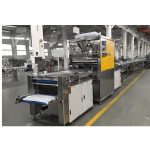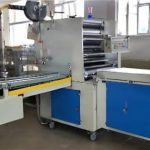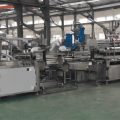
Understanding the Function of a Wrapping Machine
In the industrial sector, wrapping machines play a crucial role in packaging operations. They are designed to wrap products in a protective layer, ensuring the safety and integrity of the goods during transportation and storage. The primary function of a wrapping machine is to automate the packaging process, thereby increasing efficiency, reducing labor costs, and minimizing human error. This article delves into the various aspects of wrapping machines, including their types, applications, and benefits.
Types of Wrapping Machines
Wrapping machines come in various types, each designed for specific applications and materials. Here are some of the most common types:
1. Stretch Wrapping Machines
Stretch wrapping machines use stretchable plastic film to wrap products, typically pallets. The film is stretched and wrapped around the product, providing a secure and tight seal. These machines are widely used in warehouses and distribution centers to stabilize and protect goods during transit.
2. Shrink Wrapping Machines
Shrink wrapping machines use heat to shrink a plastic film around a product. The film is initially loose and becomes tight and secure when exposed to heat. This type of wrapping is commonly used for packaging food, beverages, and consumer goods, providing a tamper-evident seal and enhancing product presentation.
3. Flow Wrapping Machines
Flow wrapping machines, also known as horizontal form-fill-seal machines, are used to wrap products in a continuous motion. They are ideal for packaging items like candies, biscuits, and other small consumer goods. The machine forms a pouch around the product, seals it, and cuts it to the desired length.
4. Banding Machines
Banding machines apply a band or strap around a product or group of products. This method is often used for bundling newspapers, magazines, and other printed materials. Banding provides a secure hold without damaging the product.
Applications of Wrapping Machines
Wrapping machines are used across various industries due to their versatility and efficiency. Some of the key applications include:
1. Food and Beverage Industry
In the food and beverage industry, wrapping machines are essential for ensuring product safety and extending shelf life. They provide a hygienic barrier against contaminants and help maintain freshness. Shrink wrapping is particularly popular for packaging bottled beverages and canned goods.
2. Pharmaceutical Industry
The pharmaceutical industry relies on wrapping machines to package medicines and medical devices securely. These machines ensure that products are tamper-proof and comply with regulatory standards. Flow wrapping is often used for packaging individual doses or blister packs.
3. Logistics and Distribution
In logistics and distribution, wrapping machines are used to stabilize and protect goods on pallets. Stretch wrapping machines are particularly effective in securing loads, preventing shifting, and reducing damage during transportation.
4. Retail and Consumer Goods
Retailers use wrapping machines to enhance product presentation and deter theft. Shrink wrapping provides a clear view of the product while offering a tamper-evident seal. This is common for electronics, toys, and other consumer goods.
Benefits of Using Wrapping Machines
The use of wrapping machines offers several advantages, making them an integral part of modern packaging operations:
1. Increased Efficiency
Wrapping machines automate the packaging process, significantly increasing production speed and efficiency. This automation reduces the need for manual labor, allowing companies to allocate resources more effectively.
2. Cost Savings
By reducing labor costs and minimizing material waste, wrapping machines contribute to overall cost savings. The precise application of wrapping materials ensures that only the necessary amount is used, reducing excess waste.
3. Enhanced Product Protection
Wrapping machines provide a protective barrier that shields products from dust, moisture, and physical damage. This protection is crucial for maintaining product quality and extending shelf life, particularly in the food and pharmaceutical industries.
4. Improved Safety and Hygiene
Automated wrapping reduces the risk of contamination and injury associated with manual packaging processes. The use of machines ensures consistent application of wrapping materials, maintaining high hygiene standards.
Conclusion
Wrapping machines are a vital component of the packaging industry, offering numerous benefits in terms of efficiency, cost savings, and product protection. With various types available, these machines cater to a wide range of applications across different industries. As technology advances, wrapping machines continue to evolve, providing even greater capabilities and efficiencies. For businesses looking to optimize their packaging operations, investing in a suitable wrapping machine can be a game-changer, enhancing productivity and ensuring the safe delivery of products to consumers.




